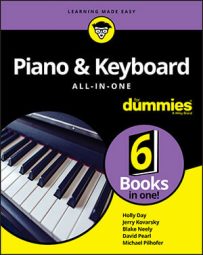You will need to know some things about tempo to play the piano or keyboard. Like heartbeats, musical beats are measured in beats per minute. A certain number of beats occur in music every minute. When a doctor tells you how fast your heart is beating, you can think, “Who cares?”
But when a composer or sheet music tells you how many musical beats occur in a specific length of musical time, you can’t take such a whimsical attitude — not if you want the music to sound right.
Look at a clock or your watch and tap your foot once every second. You’re tapping beats — one beat per second. Of course, beats can be faster or slower. Now tap your foot two times for every second.
How fast or how slow you tap these beats is called tempo. For example, when you tap one beat for every second, the tempo is 60 beats per minute (BPM) because there are 60 seconds in one minute. You’re tapping a slow, steady tempo. When you tap your foot two times per second, you’re tapping a moderately fast tempo at the rate of 120 BPM.
Composers use a tempo indication and sometimes a metronome marking to tell you how fast or slow the beat is. The tempo indication, shown above the treble staff at the beginning of the music, is a word or two that describes the beat: fast, slow, moderately fast, and so on. A metronome marking tells you the exact rate of the beat, as measured in beats per minute.
As you learn to read and play music, keep in mind that tempo indications leave a good amount of discretion to the performer and can be followed in ways not limited to the exact rate of the beat.
| Tempo Indication | Translation | BPM |
|---|---|---|
| Largo | Very slowly (broad) | 40–60 |
| Adagio | Slowly | 60–72 |
| Andante | Moderately (walking tempo) | 72–96 |
| Allegro | Fast, lively | 96–132 |
| Vivace | Lively, brisk (faster than allegro) | 132–168 |
| Presto | Very fast | 168–208 |
Don’t forget to get a metronome or a metronome app. That way you don’t have to spend all day wondering how to tap out 84 beats per minute.

